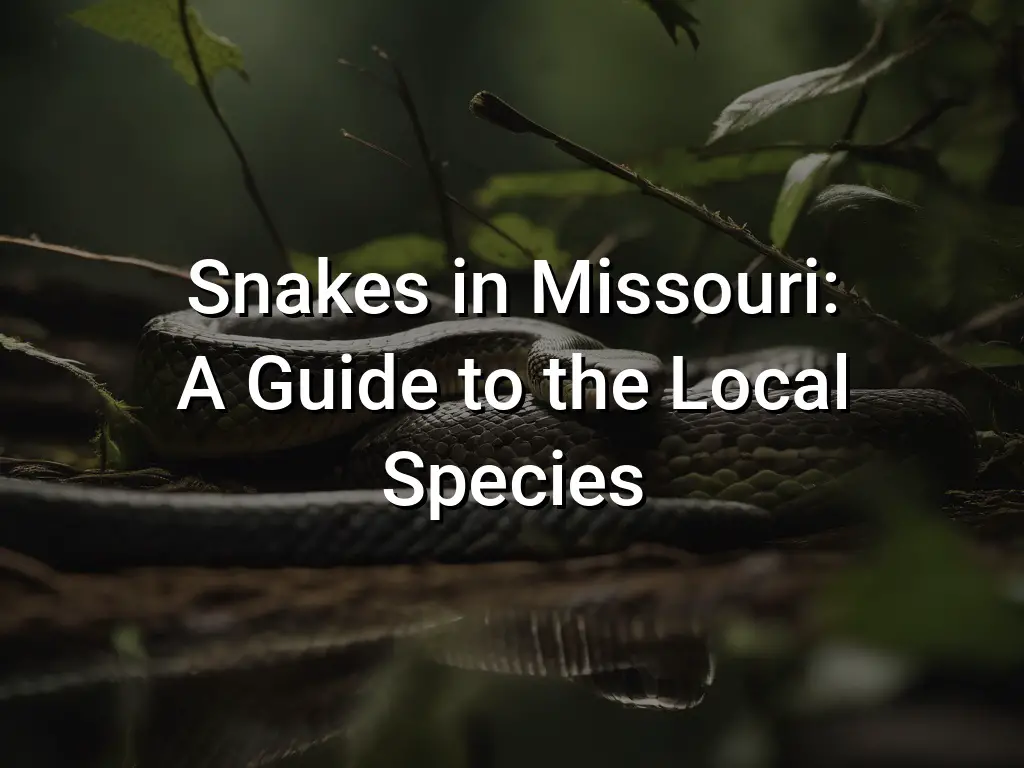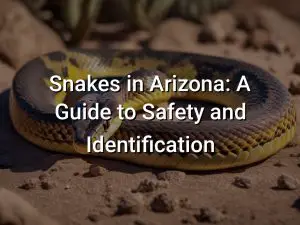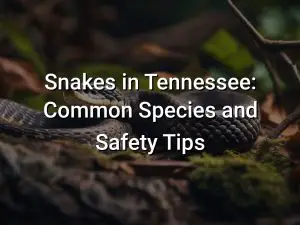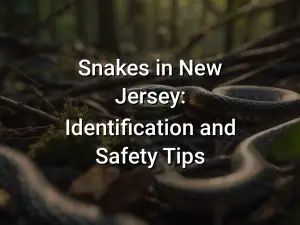Snakes in Missouri: A Guide to the Local Species

Missouri may not be the first place that comes to mind when discussing snakes, but the diverse ecosystem of this state is home to a wide variety of snake species. Whether you have a fascination for these slithering creatures or you’re simply seeking to educate yourself about the local wildlife, this guide will introduce you to the different snake species that call Missouri home.
From the venomous Copperhead Snakes to the harmless Garter Snakes, each species has its own unique characteristics and behaviors. By understanding more about these snakes, you can gain a deeper appreciation for the biodiversity in Missouri and how to coexist harmoniously with these fascinating reptiles.
Quick Links
Copperhead Snakes
Copperhead snakes are one of the venomous snake species found in Missouri. They are named for their copper-colored heads, which distinguish them from other native snakes. These snakes have a unique pattern on their bodies, with dark, hourglass-shaped bands that become wider towards their middles. Copperheads can grow to be around 2 to 3 feet long.
Copperheads are typically found in wooded areas, forests, and rocky hillsides. They are nocturnal hunters, meaning they are most active at night. Copperheads primarily feed on small rodents, insects, and amphibians. They use their venom to incapacitate their prey before consuming it.
While copperhead snakes are venomous, their bites are rarely fatal to humans. However, if bitten by a copperhead, it is important to seek medical attention immediately. Copperhead bites can cause pain, swelling, and other symptoms.
If you encounter a copperhead snake in Missouri, it is best to keep your distance and avoid provoking or handling it. Copperheads are generally shy and will only bite if they feel threatened or cornered.
It is important to be cautious and aware of your surroundings when exploring outdoor areas in Missouri to minimize the risk of encountering a snake, including copperheads. If you suspect there may be copperhead snakes in the area, it is advisable to wear protective clothing, such as long pants and boots, and watch your step.
Remember, snakes play an important role in ecosystems and should be respected and left undisturbed in their natural habitats.
Timber Rattlesnakes
Timber Rattlesnakes, also known as Crotalus horridus, are venomous snakes that are native to Missouri. They are the largest venomous snake species in the state and are known for their distinctive rattling sound, which serves as a warning to potential threats.
These snakes have a unique appearance, with a gray or light brown background color and dark crossbands that run along their bodies. Their bodies are stout and can reach lengths of up to five feet. Timber Rattlesnakes have a triangular-shaped head and heat-sensing pits on their faces, which help them detect prey.
Timber Rattlesnakes can be found in a variety of habitat types in Missouri, including forests, rocky outcrops, and grasslands. They prefer areas with ample cover, such as fallen logs, brush piles, and rock crevices, where they can hide and ambush their prey.
These snakes are primarily ambush predators, feeding on small mammals, birds, and amphibians. They have a venomous bite that they use to subdue their prey. Their venom is not often fatal to humans, but it can cause pain, swelling, and tissue damage if bitten.
Timber Rattlesnakes are a threatened species in Missouri due to habitat loss, persecution, and illegal collection. It is illegal to kill, capture, or harass these snakes in the state. If you encounter a Timber Rattlesnake, it is best to observe it from a safe distance and leave it alone.
Remember, snakes play an important role in the ecosystem by controlling rodent populations and maintaining the balance of nature. It’s essential to respect and appreciate these creatures from a distance while enjoying the outdoors in Missouri.
Water Snakes
Water snakes are a common sight in Missouri’s waterways, with several species found throughout the state. These non-venomous snakes are adapted to aquatic habitats and are often found near rivers, lakes, and marshes.
One species of water snake found in Missouri is the Diamondback Water Snake. As the name suggests, these snakes have a distinct diamond pattern on their backs. They can grow up to 4 feet long and are known for their aggressive behavior when threatened. However, they are harmless to humans and play an important role in controlling populations of small fish and amphibians in their habitats.
Another species is the Northern Water Snake, which is often mistaken for a venomous water moccasin due to its similar appearance. These snakes have a dark brown or black body with dark bands across their backs. They are known for their ability to swim and hunt both in water and on land. Northern Water Snakes can reach lengths of up to 4.5 feet and are known for their feisty temperament when handled.
The last species of water snake found in Missouri is the Plain-Bellied Water Snake. These snakes have a plain brown or olive-colored belly and are typically gray or brown on top. They are smaller than the other water snake species, usually only growing up to 2.5 feet long. Plain-Bellied Water Snakes feed on a variety of aquatic prey, including frogs, fish, and crayfish.
When encountering water snakes in Missouri, it’s important to remember that they are not aggressive towards humans and will generally try to flee when approached. It is illegal to kill, harm, or capture these snakes in Missouri, as they play an important role in the ecosystem. If you come across a water snake, simply admire it from a distance and allow it to continue on its way.
Kingsnakes
Kingsnakes are a type of non-venomous snake that can be found in Missouri. They are known for their striking pattern of bands or rings, which can vary in color and pattern depending on the species. These snakes are named “kingsnakes” because they are often found preying on other snakes, including venomous species.
One of the most common species of kingsnake in Missouri is the Eastern Kingsnake. This species is usually black with yellow or white bands, but the coloration can vary. Eastern Kingsnakes are known for their habit of eating other snakes, including venomous copperheads and rattlesnakes.
Another species of kingsnake that can be found in Missouri is the Speckled Kingsnake. This species has a dark brown or black color with yellow or white speckles. Speckled Kingsnakes are also known to eat other snakes, making them a valuable asset in controlling populations of venomous species.
Kingsnakes are generally docile and rarely pose a threat to humans. They are beneficial to have around as they help control the population of other snakes, including venomous ones. If you encounter a kingsnake in the wild, it is best to observe it from a safe distance and appreciate its role in the ecosystem.
Black Rat Snakes
Black Rat Snakes, also known as Eastern Rat Snakes, are common throughout Missouri. They are large, non-venomous snakes known for their shiny black scales and white bellies. These snakes are excellent climbers and can often be found in trees or on high structures.
Black Rat Snakes are opportunistic hunters and primarily feed on small mammals such as rats, mice, and squirrels. They are also known to eat birds, eggs, and amphibians. These snakes play an important role in controlling rodent populations.
These snakes are typically docile and non-aggressive. However, when threatened, they may vibrate their tails in leaves to mimic the sound of a rattlesnake, a behavior known as tail vibration. This is a defensive mechanism to deter predators.
Black Rat Snakes are important for the ecosystem and should be appreciated and respected. If you encounter one in the wild, it is best to observe from a safe distance and allow the snake to go about its activities undisturbed.
Milk Snakes
Milk snakes are non-venomous snakes that are commonly found in Missouri. They are known for their vibrant colors, which can include red, black, and yellow bands that resemble the colors of a coral snake. This similarity to coral snakes has led to the popular saying, “Red touches yellow, kills a fellow; red touches black, friend of Jack,” to help differentiate between the two species.
Milk snakes are constrictors, meaning they wrap their bodies around their prey to suffocate them. They primarily eat small mammals, birds, and reptiles, and are known to be quite adaptable when it comes to their diet. They are also nocturnal hunters, using their keen sense of smell and heat-sensitive pits to locate prey in the darkness.
These snakes are typically found in a variety of habitats, including forests, grasslands, and rocky areas. They are often encountered near human settlements, as they are known to seek out shelter in barns, sheds, and gardens. Milk snakes are generally not aggressive towards humans and will only bite if they feel threatened.
It’s important to note that while milk snakes are non-venomous, they can still bite, and their bite can cause minor injuries and potential infections. If you encounter a milk snake in the wild, it is best to observe it from a safe distance and not attempt to handle it.
Overall, milk snakes are fascinating reptiles that play an important role in Missouri’s ecosystem. They help control populations of small mammals and contribute to the overall balance of the local wildlife.
Garter Snakes
Garter snakes are a common species of snake found in Missouri. They are non-venomous and have distinctive markings, with three longitudinal stripes running down their bodies. These stripes can be green, brown, or black in color.
Garter snakes are typically found in a variety of habitats, including woodlands, grasslands, and wetlands. They are often encountered near water sources such as ponds, streams, and marshes.
These snakes are relatively small, usually measuring between 18 to 26 inches in length. They have slender bodies and keeled scales. Garter snakes are active during the day and are often seen basking in the sun to regulate their body temperature.
Garter snakes primarily feed on small prey such as frogs, toads, fish, and insects. They are known for their ability to catch and consume prey that is larger than their own head.
During the breeding season, female garter snakes release pheromones to attract males. Multiple males may compete for the opportunity to mate with a female, resulting in a behavior known as a “mating ball.”
When threatened, garter snakes will often release a foul-smelling musk as a defense mechanism. They may also vibrate their tails as a form of mimicry, imitating the rattling sound of a venomous snake.
Overall, garter snakes play an important role in the ecosystem by controlling populations of small prey species. While they may startle some people due to their appearance, garter snakes are harmless and beneficial to have in the environment.
Eastern Massasauga Rattlesnakes
The Eastern Massasauga Rattlesnake is a venomous snake species that can be found in Missouri. It is a small to medium-sized rattlesnake, with adults typically measuring between 2 and 3 feet in length. These snakes have a distinctive rattling sound that they use as a warning signal when they feel threatened.
Eastern Massasaugas are typically found in wetland areas such as marshes, swamps, and floodplains. They are not aggressive snakes and will generally try to avoid human interaction. However, if provoked or cornered, they may bite in self-defense.
The venom of the Eastern Massasauga Rattlesnake is potent and can cause significant harm to humans. If you encounter this snake in the wild, it is important to give it a wide berth and not attempt to handle or disturb it.
In Missouri, Eastern Massasauga Rattlesnakes are listed as a species of conservation concern. They are protected by state law, and it is illegal to kill, collect, or possess them without the proper permits.
If you come across an Eastern Massasauga Rattlesnake in Missouri, it is best to appreciate it from a safe distance and allow it to continue on its way. Remember, snakes play an important role in the ecosystem as predators of small mammals and help to control populations of rodents.
It is always a good idea to familiarize yourself with the local snake species in your area to better understand and appreciate these remarkable creatures. Stay informed and stay safe!
Brown Snakes
Brown snakes are a common species found in Missouri. They are small and slender, typically measuring around 9-13 inches in length. Despite their small size, brown snakes are exceptionally good at hiding and blending into their surroundings.
These snakes are non-venomous and pose no threat to humans. They primarily feed on insects, slugs, and other small invertebrates. Brown snakes can often be found in forests, meadows, and gardens, where they hunt for their prey.
When threatened, brown snakes may release a foul-smelling musk as a defense mechanism. They are usually docile and prefer to retreat rather than confront a potential threat.
Brown snakes are beneficial to the ecosystem as they help control insect populations. If you encounter a brown snake in the wild, it’s best to observe from a distance and allow it to continue on its way.
Western Worm Snakes
Western Worm Snakes, also known as Carphophis vermis, are a small and non-venomous species of snake found in Missouri. They belong to the Colubridae family and can be identified by their slender bodies and small size, typically growing up to 10-15 inches in length.
These snakes have smooth scales that are usually brown or gray in color with a pinkish or reddish hue on their bellies. They have a distinctive blunt snout, which they use to burrow into the soil in search of earthworms, their primary source of food.
Western Worm Snakes are primarily found in forested areas, particularly in damp and mossy environments. They prefer to live underground and are often found in leaf litter, loose soil, and decaying logs. They are excellent burrowers and spend most of their time hidden beneath the ground.
Despite their secretive nature, Western Worm Snakes are harmless to humans and pose no threat. They are known for their docile behavior and rarely bite unless provoked or handled improperly. If encountered, it is best to observe these snakes from a distance and avoid disturbing their habitat.
Western Worm Snakes play an important role in the ecosystem as they help control the population of earthworms, which in turn affects the health of the soil. They also serve as a food source for larger predators, such as birds and mammals.
Overall, Western Worm Snakes are an interesting and unique species that contribute to the biodiversity of Missouri. By understanding and appreciating these snakes, we can foster a greater respect for the natural world and the importance of conservation efforts.
Conclusion
Now that you have a better understanding of the various snake species found in Missouri, you can approach encounters with these creatures with more knowledge and confidence. Remember that snakes play an important role in the ecosystem and are generally not a threat to humans if left undisturbed.
If you do come across a snake, it’s best to give it space and avoid any sudden movements. If you have concerns about the presence of snakes in your area, it’s always a good idea to consult with local wildlife experts or pest control professionals to ensure the safety of both yourself and the snakes.







